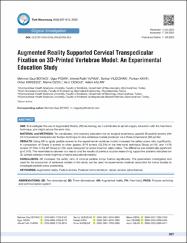| dc.contributor.author | Boyacı, Mehmet Gazi | |
| dc.contributor.author | Fidan, Uğur | |
| dc.contributor.author | Yuran, Ahmet Fatih | |
| dc.contributor.author | Yıldızhan, Serhat | |
| dc.contributor.author | Kaya, Furkan | |
| dc.contributor.author | Kimsesiz, Ömer | |
| dc.contributor.author | Özdil, Merve | |
| dc.contributor.author | Cengiz, Akın | |
| dc.contributor.author | Aslan, Adem | |
| dc.date.accessioned | 2021-05-05T22:14:11Z | |
| dc.date.available | 2021-05-05T22:14:11Z | |
| dc.date.issued | 2020 | |
| dc.identifier.issn | 1019-5149 | |
| dc.identifier.uri | https://doi.org/10.5137/1019-5149.JTN.30733-20.2 | |
| dc.identifier.uri | https://hdl.handle.net/20.500.12933/351 | |
| dc.description | Aslan, Adem/0000-0001-9432-5399; Boyaci, Mehmet Gazi/0000-0001-7329-2102; YURAN, AHMET FATIH/0000-0002-2105-2614 | en_US |
| dc.description | WOS:000593272300020 | en_US |
| dc.description | PubMed: 33216344 | en_US |
| dc.description.abstract | AIM: To investigate the use of Augmented Reality (AR) technology as it contributes to spinal surgery education with the free-hand technique, and might reduce the error ratio. MATERIAL and METHODS: Ten candidates, with anatomy education but no surgical experience, applied 36 pedicle screws with C2-C3 posterior transpedicular fixation technique to nine vertebrae models produced via a three-dimensional (3D) printer. RESULTS: Using AR to apply pedicle screws to the experimental vertebrae model increased the safety screw ratio significantly. In comparison of Grade 0 screws to other grades: 6/18 screws (33.3%) in the free-hand technique Group (n=18), and 14/18 screws (77.8%) in the AR Group (n=18), were measured for screw insertion safety ratios. The difference was statistically significant (p=0.018). The resemblance between our results and the results of previous studies researching supportive systems indicates our 3D printed vertebra model might be a helpful educational material. CONCLUSION: AR increases the safety ratio of cervical pedicle screw fixation significantly. The parameters investigated and used for the production of vertebrae models in this study can be used for experimental material production for future studies to investigate pedicle screw positioning. | en_US |
| dc.language.iso | eng | en_US |
| dc.publisher | Turkish Neurosurgical Soc | en_US |
| dc.rights | info:eu-repo/semantics/openAccess | en_US |
| dc.subject | Augmented reality | en_US |
| dc.subject | Pedicle screws | en_US |
| dc.subject | Posterior instrumentation | en_US |
| dc.subject | Upper cervical spine fracture | en_US |
| dc.title | Augmented Reality Supported Cervical Transpedicular Fixation on 3D-Printed Vertebrae Model: An Experimental Education Study | en_US |
| dc.type | article | en_US |
| dc.department | AFSÜ, Tıp Fakültesi, Cerrahi Tıp Bilimleri Bölümü, Beyin ve Sinir Cerrahisi Ana Bilim Dalı | en_US |
| dc.contributor.institutionauthor | Boyacı, Mehmet Gazi | |
| dc.contributor.institutionauthor | Yıldızhan, Serhat | |
| dc.contributor.institutionauthor | Kaya, Furkan | |
| dc.contributor.institutionauthor | Kimsesiz, Ömer | |
| dc.contributor.institutionauthor | Özdil, Merve | |
| dc.contributor.institutionauthor | Cengiz, Akın | |
| dc.contributor.institutionauthor | Aslan, Adem | |
| dc.identifier.doi | 10.5137/1019-5149.JTN.30733-20.2 | |
| dc.identifier.volume | 30 | en_US |
| dc.identifier.issue | 6 | en_US |
| dc.identifier.startpage | 937 | en_US |
| dc.identifier.endpage | 943 | en_US |
| dc.relation.journal | Turkish Neurosurgery | en_US |
| dc.relation.publicationcategory | Makale - Uluslararası Hakemli Dergi - Kurum Öğretim Elemanı | en_US |
















